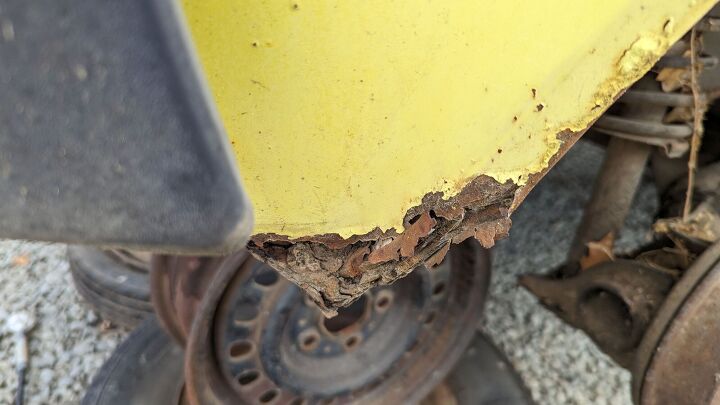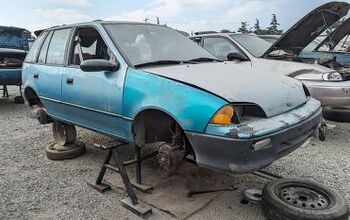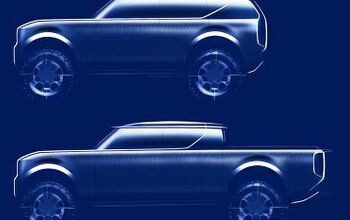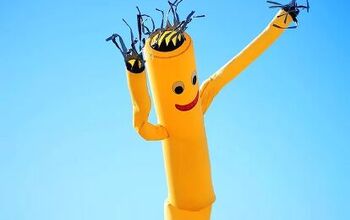Junkyard Find: 1975 Volkswagen Rabbit 4-Door

From the time of the first KdF-Wagens until distressingly deep into the 1970s, Volkswagens had air-cooled engines in back and rode on goofy 1930s chassis designs. Finally, the Audi 80-based Dasher showed up here as a 1974 model, but it wasn't until the following model year that the first true water-cooled VW went on sale in North America.
This was the 1975 Volkswagen Rabbit, known as the Golf back home (some claim the Golf-based Scirocco may have hit US showrooms a few days before the Rabbit; please discuss in comments). While new air-cooled Beetles remained available here through 1979, sales of those relics fell off a cliff while the revolutionary new hatchback became an instant sales hit on our continent.
Since I began documenting interesting discarded vehicles, 16 years ago, I'd been seeking a first-year Rabbit in car graveyards all over the country. The closest I'd come was a '77 two-door in Denver, but then I hit pay dirt in a Northern California yard last week. Behold the November 1974 date of manufacture on the build sticker!
This yard also has an early Peugeot 505 Turbodiesel, an Oldsmobile Toronado Troféo and even an example of the long-forgotten VW Jetta Hybrid. It was a productive stop on my NorCal Fall Junkyard Tour.
The main reason it's so tough to find a 1975 Rabbit in the boneyards these days is the eagerness with which these cars dissolved into heaps of red powder. Even in not-so-rusty California, they tended to rot in any location that winter rainwater could collect.
It wouldn't have been a challenge to find a '75 Rabbit in California wrecking yards during the 1980s and 1990s, of course. Plenty were sold in the Golden State.
This one has many years of leaf mulch built up in the usual spots, so it's likely that it stopped being driven decades ago and sat in a driveway or yard until everyone got tired of looking at it. That's when Pick-n-Pull got the call to drag it away.
This car came with a 1.5-liter carbureted engine rated at 70 horsepower and 81 foot-pounds.
Yes, that's a points distributor. Futuristic electronic fuel-delivery and ignition hardware came a bit later for the Rabbit. For 1976, the Rabbit got a 1.6-liter engine with one apiece additional horse and pound-foot. With a car weighing just 1,827 pounds, that power upgrade helped.
At least this one has front disc brakes; supposedly, some of the early base-model 1975 Rabbits came with four-wheel-drums.
The 1975 Rabbit was available with two or four doors, in base, Custom or Deluxe trim levels.
MSRP for the four-door started at $3,139, or about $18,498 in 2023 dollars. Meanwhile, your friendly American VW dealership would sell you a shiny new Beetle for $2,895 ($17,060 today) or a Super Beetle for $3,095 ($18,239 now).
The price went up 250 bucks ($1,473 after inflation) if you insisted on an automatic transmission in your 1975 Rabbit. This one has the four-speed manual.
The factory idiot lights must have been insufficient for one of this car's early owners, because these aftermarket gauges have been installed.
The vacuum gauge makes some sense for drivers who needed a reminder to keep a light foot on the throttle to save gas during the 1979 Oil Crisis, but why risk the danger of a fuel line in the passenger compartment in order to have a fuel-pressure gauge on a carbureted engine? The junkyard always offers such mysteries for its visitors.
Was it worth restoring? Absolutely not.
Still, local owners of early Mk1 Golfs will be happy about the parts bonanza offered by this car, and I was happy with the historical bonanza (especially so soon after discovering a nearly-as-rare first-year Nissan Altima).
Zero to 50 in a snappy 8.2 seconds. Happy days are here again!
It beat eight other "super economy cars" and not by a hair, according to Road & Track.
This '75 Scirocco commercial was a lot more fun than the ones for its Rabbit cousin, so let's watch it.
[Images: The author]
Become a TTAC insider. Get the latest news, features, TTAC takes, and everything else that gets to the truth about cars first by subscribing to our newsletter.

Murilee Martin is the pen name of Phil Greden, a writer who has lived in Minnesota, California, Georgia and (now) Colorado. He has toiled at copywriting, technical writing, junkmail writing, fiction writing and now automotive writing. He has owned many terrible vehicles and some good ones. He spends a great deal of time in self-service junkyards. These days, he writes for publications including Autoweek, Autoblog, Hagerty, The Truth About Cars and Capital One.
More by Murilee Martin
Latest Car Reviews
Read moreLatest Product Reviews
Read moreRecent Comments
- Jeff If we are worried about the Chinese spying on us and gathering information then we need to make certain specifications on vehicles imported from China that would lessen any concerns about this. I don't see how we could eliminate all information gathering especially if that vehicle has connectivity to your phone.
- ToolGuy Oh look what's this?
- Jkross22 Gotta stop the spying Chinese!!!! Please. These parasites don't care about spying unless they're the ones profiting. US Commerce Secretary... another useless job that should be done away with.
- Canam23 I've rented them and found them...fine. I wish Ford had continued with or came up with a new generation Fusion which was a far better sedan.
- MaintenanceCosts The ES will do well in an electric version, assuming it's more thoroughly baked than the half-finished RZ. There's plenty of the Lexus customer base who use planes whenever they travel and don't need to drive their own cars outside the metro area.

















































Comments
Join the conversation
My mother owned a 1979 (Bought in Dec '78) VW Rabbit GL Tan on Tan vinyl, made in Pennsylvania. First of a new generation with fuel injection, electric cooling fans and a 3 speed Automatic. We traveled all over the place in it. We had electrical gremlins in it. It had a gift of snapping the accelerator cable multiple times. Fuel economy stunk for such a small car. We parted ways in July 1991. Super sad moment.
VW was an early adopter of Fuel injection. The Bosch K Jetronic made them quick, economical, but especially more drivable than much of the competition. Interestingly, VW stayed with points and condensers until 1981 when they started using a Hall sending unit eliminating points.